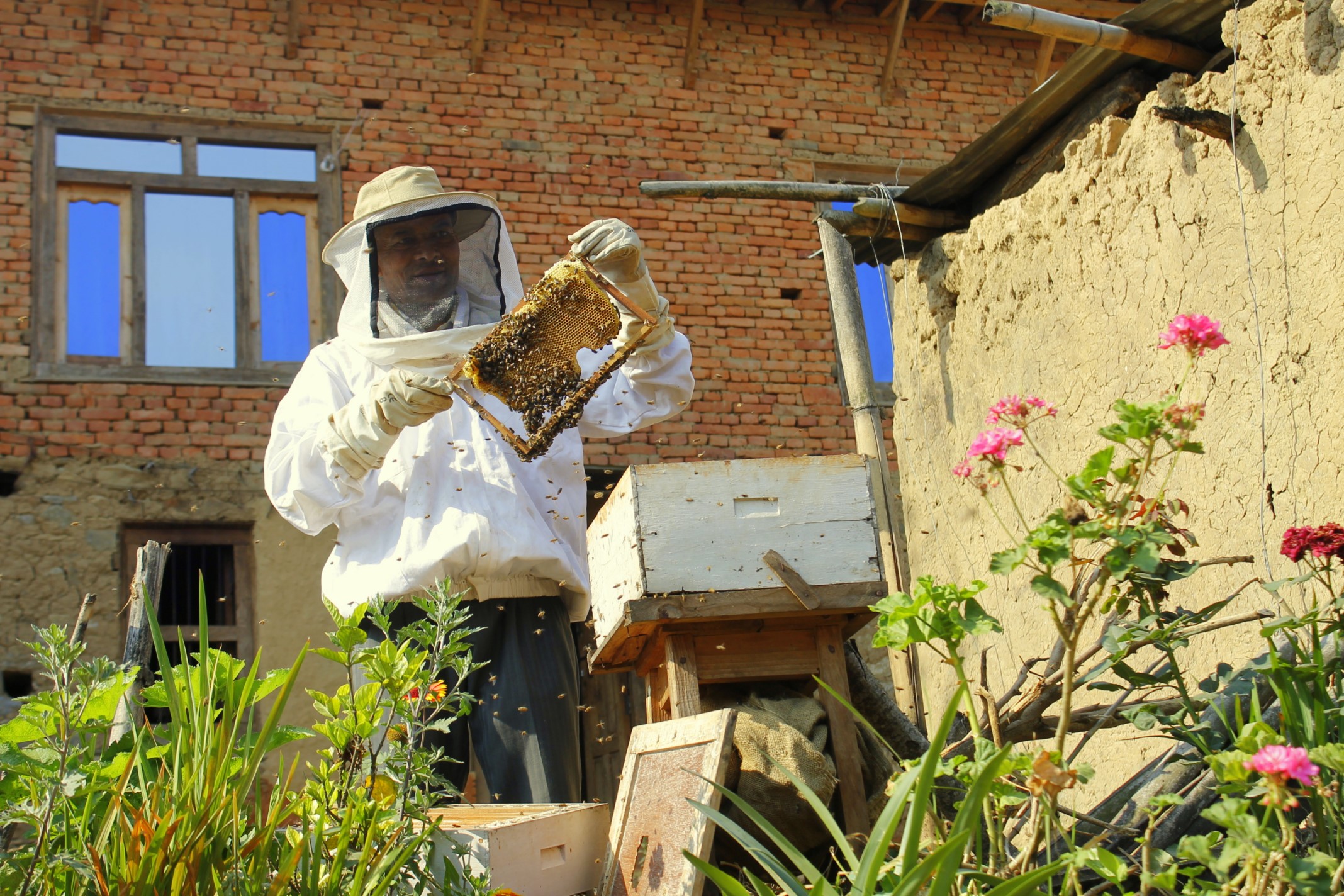Beekeeping in Nepal on:
[Wikipedia]
[Google]
[Amazon]

* JOSHI, S.R, Ahmad, F and Gurung M.B. “Participatory Action Research on Api cerena, selection and multiplication in Nepal”. Improving Livelihoods Through Beekeeping. Accessed November, 2014
* MOLES, Emile. « Voyage au Népal: article paru dans l' Abeille de France. » Emile Molès. Musée du Miel, accessed November 3, 2014
* Nicola Bradbear. “Le rôle des abeilles dans le développement rural.” FAO. Accessed November 2014
* RAIZADA, Manish. « Introduction to Nepal.» AgTrade, Nepal Canada, Myla Manser. Accessed November 9, 2014
* THAPA, Ratna. « Département de Zoologie, TriChandra M. Campus, B.P. 4462, Kathmandu, NEPAL.»APIMONDIA Foundation, accessed November 10, 2014
{{BeeColonyMemberTypes Agriculture in Nepal
Nepal
Nepal (; ne, :ne:नेपाल, नेपाल ), formerly the Federal Democratic Republic of Nepal ( ne,
सङ्घीय लोकतान्त्रिक गणतन्त्र नेपाल ), is a landlocked country in S ...
is known for its ancestral technology of beekeeping: geographical conditions and lack of modern equipment have forced the collectors to risk their lives. Apiculture
Beekeeping (or apiculture) is the maintenance of bee colonies, commonly in man-made beehives. Honey bees in the genus '' Apis'' are the most-commonly-kept species but other honey-producing bees such as ''Melipona'' stingless bees are also kept. ...
in Nepal began 20 years ago but is still not very developed. Different species of honey-producing bees are found in Nepal. Only two of them are raised for apiculture: ''Apis cerana
''Apis cerana'', the eastern honey bee, Asiatic honey bee or Asian honey bee, is a species of honey bee native to South, Southeast and East Asia. This species is the sister species of ''Apis koschevnikovi'' and both are in the same subgenus as ...
'' and '' Apis mellifera''. These species have several qualities that are desired by humans and are vital for the pollination
Pollination is the transfer of pollen from an anther of a plant to the stigma of a plant, later enabling fertilisation and the production of seeds, most often by an animal or by wind. Pollinating agents can be animals such as insects, birds, a ...
of flowers and forests. Bees are also useful for agriculture
Agriculture or farming is the practice of cultivating plants and livestock. Agriculture was the key development in the rise of sedentary human civilization, whereby farming of domesticated species created food surpluses that enabled people t ...
which is an important activity in Nepal but they have become threatened by deforestation
Deforestation or forest clearance is the removal of a forest or stand of trees from land that is then converted to non-forest use. Deforestation can involve conversion of forest land to farms, ranches, or urban use. The most concentrated ...
and parasites (e.g. varroa
''Varroa'' is a genus of parasitic mesostigmatan mites associated with honey bees, placed in its own family, Varroidae. The genus was named for Marcus Terentius Varro, a Roman scholar and beekeeper. The condition of a honeybee colony being infe ...
).
Bee species
''Apis mellifera'' and ''Apis cerana
''Apis cerana'', the eastern honey bee, Asiatic honey bee or Asian honey bee, is a species of honey bee native to South, Southeast and East Asia. This species is the sister species of ''Apis koschevnikovi'' and both are in the same subgenus as ...
'' are the only honey-producing bees known in Nepal.
''A. cerana'' lives in Nepal at an altitude of 60 to 3500 m (Thapa, 2001) and produces honey two times a year. The first time is during the summer (March to May) and the second time during the winter (November to December).
''A. cerana'' is much more resistant than Apis mellifera to cold and predators. During the winter, most Apis cerana colonies are reduced because of the harsh weather and the low amount of flowers. Nevertheless, compared to ''A. mellifera, A. cerana'' can survive in low temperatures (i.e. -0,1 °C) (Thapa, 2001) because their beehives (i.e. log hive) can protect themselves from the cold. Furthermore, ''A. cerana'' is resistant to the parasite, Varroa destructor. The acarid breed feeds on bees’ larva. ''A. melifera'' is very sensitive to this parasite and causes an incapacity to fly, an abdominal malformation and appearance of cannibalism (Experimental and Applied Acarology, 2000).
''A. cerana'' is very famous in Nepal because of the low cost of its beehive, the log hive. Farmers can build their own beehives. The principle is to dig a hole in a trunk (the size is about 50 cm in diameter and 65 cm in height), and then a cap is necessary to protect the top of the beehive from cold and predators (e.g. '' Marte flavigula'').
Honey development
In the Teraï, a region located at an altitude of 60 to 300 m (FAO), there are counts of about 120 000 colonies of ''A. cerana'' (Thapa, 2001). The flat land area with varieties of flowering plants have made honey-production successful in nooks and corners of Teraï region. The weather is moderate all year long. The log hives permit honey production from ''A. cerana''.References
* Anonymous. « Apiculture traditionnelle et patrimoine, le Népal. » Encyclopédie Universelle, anonymous. Accessed November 12, 2014* JOSHI, S.R, Ahmad, F and Gurung M.B. “Participatory Action Research on Api cerena, selection and multiplication in Nepal”. Improving Livelihoods Through Beekeeping. Accessed November, 2014
* MOLES, Emile. « Voyage au Népal: article paru dans l' Abeille de France. » Emile Molès. Musée du Miel, accessed November 3, 2014
* Nicola Bradbear. “Le rôle des abeilles dans le développement rural.” FAO. Accessed November 2014
* RAIZADA, Manish. « Introduction to Nepal.» AgTrade, Nepal Canada, Myla Manser. Accessed November 9, 2014
* THAPA, Ratna. « Département de Zoologie, TriChandra M. Campus, B.P. 4462, Kathmandu, NEPAL.»APIMONDIA Foundation, accessed November 10, 2014
{{BeeColonyMemberTypes Agriculture in Nepal
Nepal
Nepal (; ne, :ne:नेपाल, नेपाल ), formerly the Federal Democratic Republic of Nepal ( ne,
सङ्घीय लोकतान्त्रिक गणतन्त्र नेपाल ), is a landlocked country in S ...